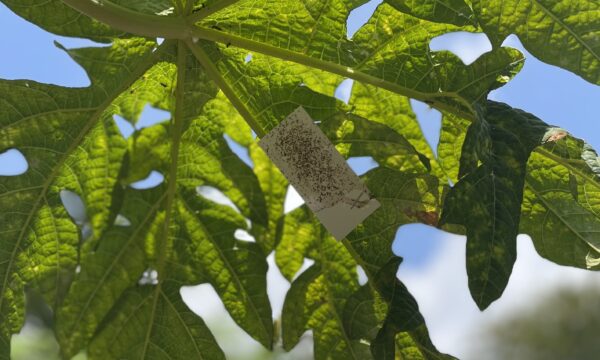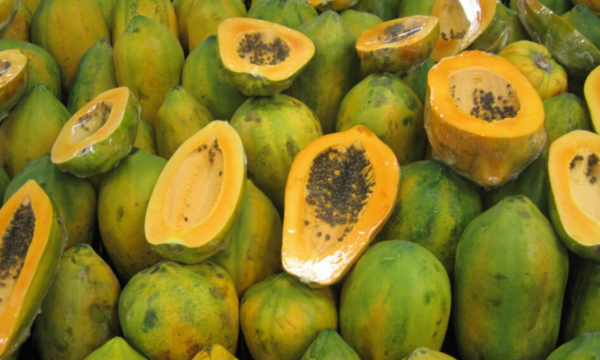
Scanning electron micrograph of a soybean cyst nematode and egg © Ethan Hein via Flickr (License CC-BY-NC-SA 2.0)
Soybean (Glycine max) is an important crop that provides a sustainable source of protein and oil worldwide in countries such as the USA, Brazil, Argentina, India and many African countries, including Nigeria, South Africa and Uganda. The soybean cyst nematode Heterodera glycines is a microscopic roundworm that feeds on the roots of soybean and is a major constraint to soybean production. This nematode causes more than US$1 billion in yield losses annually in the United States alone, making it the most economically important pathogen on soybean. For over 50 years the planting of resistant cultivars and crop rotation have been the main management strategy for this pathogen, and only a few resistant plant types are used due to undesirable traits in other resistant varieties of soybean. Moreover, the increase in virulent populations of the nematode on most known resistant plant sources coupled with the very limited knowledge of soybean resistance mechanism makes the development of new approaches for control of soybean cyst nematode a necessity.
Soybean cyst nematodes hatch from eggs in the soil and migrate to the roots of soybean plants where each nematode feeds from a single soybean plant cell each. They then inject the plant cell with effector proteins which transform the plant cell into a large, highly nutritious ‘feeding cell’ which sustains the nematode throughout its development. Heavy infestations of soybean cyst nematodes will damage the soybean roots to the extent that nutrients can not be effectively supplied to the rest of the plant. Natural plant resistance mechanisms lead to the death of the cell the nematode is feeding from, thereby preventing the nematode from feeding. Further research aims to identify the exact mechanism leading to the death of the cells the nematodes are feeding from, to pinpoint exactly how the SHMT gene plays a role in resistance mechanisms, which is thought to be a highly complex defense response against the root pathogen.
Recently there has been considerable research on soybean resistance to the soybean cyst nematode by scientists including Khlaid Meksem’s research team from Southern Illinois University, Matt Hudson and Brian Diers from the University of Illinois, Andrew Bent from the University of Wisconsin and a team of researchers from the University of Missouri and Iowa State University. This group of researchers have identified an area on chromosome 18 called Rhg1 (for resistance to Heterodera glycines 4) that is known to be the location of the main source of soyabean cyst nematode resistance. Rhg1 disrupts the formation and maintenance of potential nematode-feeding sites on plant roots. The gene responsible for nematode resistance is hydroxymethyltransferase (SHMT). This gene encodes an enzyme that plays many important roles for example producing folate, a necessary nutrient for both plants and animals. Further work has shown that nearly every soybean variety that is known to be resistant has more than one set of these genes. After establishing this scientists have then been able to artificially increase the expression rate of three resistant genes together on soybean roots to replicate the resistance effect.
The results are particularly interesting because having several genes next to each other that control the same trait is unusual in multicellular organisms. Consequently the findings mark the discovery of a new mechanism of plant resistance which can be used to artificially engineer better resistant soybean varieties. The newly acquired knowledge of the soybean resistance gene will have great benefits for plant breeders and the commercial soybean industry now it is known which genes to select for when breeding resistant soybean varieties.
The recent research in this area has greatly increased the understanding of the fascinating but little known interaction between soya bean plants and the nematode pathogen, and will ultimately lead to the development of new novel strategies to enhance the nematode resistance of soybean crops.
To view a video about this research, please click here
References:
Timothy Wall, 2012, ‘Mystery of Nematode Pest Resistant Soybeans Cracked by MU Scientists’
Susan Jongeneel, 2012, ‘Strengthening a Billion Dollar Gene in Soybeans’
Roger Meissen, 2012, ‘Gene Points to Entirely New Resistance Gene Against Pathogen’
Cook, D., Lee, T., Guo, X., Melito, S., Wang, K., Bayless, A., Wang, J., Hughes, T., Willis, D., Clemente, T., Diers, B., Jiang, J., Hudson, M., & Bent, A. (2012). Copy Number Variation of Multiple Genes at Rhg1 Mediates Nematode Resistance in Soybean Science DOI: 10.1126/science.1228746
Kandoth, P., Ithal, N., Recknor, J., Maier, T., Nettleton, D., Baum, T., & Mitchum, M. (2011). The Soybean Rhg1 Locus for Resistance to the Soybean Cyst Nematode Heterodera glycines Regulates the Expression of a Large Number of Stress- and Defense-Related Genes in Degenerating Feeding Cells PLANT PHYSIOLOGY, 155 (4), 1960-1975 DOI: 10.1104/pp.110.167536
Liu, S., Kandoth, P., Warren, S., Yeckel, G., Heinz, R., Alden, J., Yang, C., Jamai, A., El-Mellouki, T., Juvale, P., Hill, J., Baum, T., Cianzio, S., Whitham, S., Korkin, D., Mitchum, M., & Meksem, K. (2012). A soybean cyst nematode resistance gene points to a new mechanism of plant resistance to pathogens Nature DOI: 10.1038/nature11651
Related News & Blogs
‘Sowing the seeds’ for food security in Uganda: CABI supports training for Quality Declared Seed production
CABI has been working with Zirobwe Agali-Awamu Agribusiness Training Association (ZAABTA), the Ministry of Agriculture, Animal Industry and Fisheries (MAAIF), the National Agricultural Research Organisation (NARO), and Integrated Seed Sector Developmen…
21 May 2025




